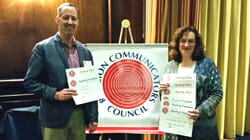What would it take to improve police interactions with people with disabilities?
By Curtis Ramsey-Lucas
On July 18, the White House convened a forum on disability and criminal justice reform. Ronald Hampton, an advisory board member for the National Association for Police Accountability, was a panelist at the event. A retired police officer with the District of Columbia Metropolitan Police Department with more than 20 years on the force, Mr. Hampton is the father of an adult son with autism. He shared his concern for his son interacting with police, given the possibility for misunderstanding in such situations. He and other parents of children with autism in the metro D.C. area have developed a support system and phone network so they can call each other, rather than calling police, when assistance is needed.
That same day in North Miami, Fla., police shot Charles Kinsey in the leg as he was attempting to assist a man with autism who had wandered from his group home. Kinsey, a behavioral therapist at the group home, located the man with autism who was sitting in the street playing with a toy truck. In a cell phone video of the incident, Kinsey can be heard trying to calm the man while telling police he was holding a toy truck, not a gun. The Washington Post reported that a police union representative indicated “the officer was aiming for the man with autism— apparently thinking he was armed—and was trying to protect Kinsey.”
Earlier this year, the Ruderman Family Foundation released a report noting that individuals with disabilities comprise one-third to one-half of all people killed by law enforcement officers and are “the majority of those killed in use-of-force cases that attract widespread attention. This is true both for cases deemed illegal or against policy and for those in which officers are ultimately fully exonerated.” The report faults the media for ignoring the disability component in these stories or telling them in ways that intensify stigma and ableism.
According to the report, “When we leave disability out of the conversation or only consider it as an individual medical problem, we miss the ways in which disability intersects with other factors that often lead to police violence. Conversely, when we include disability at the intersection of parallel social issues, we come to understand the issues better, and new solutions emerge.”
One of these solutions is the use of crisis intervention teams in law enforcement. States and localities that have employed these teams have seen fewer injuries and deaths among officers and people with psychiatric or intellectual and developmental disabilities, increased jail diversion rates, fewer lawsuits following crisis incidents, and stronger ties with mental health and disability communities.
In addition, appointing police liaison officers and deploying specialized police officers and non-police officers, including police chaplains trained in crisis intervention techniques, improves police responses in situations involving psychiatric and other disabilities through the delivery of specialized knowledge, skills and experience. And better training of police officers to understand intellectual and developmental disabilities and psychiatric disabilities improves interactions between police and individuals with disabilities in crisis situations.
Most important, however, is ensuring that people with disabilities receive the community services they need and preventing these law enforcement encounters from happening in the first place. We must stop using our law enforcement system as a substitute for a failing disability service system. The rates of justice involvement among people with disabilities reflect in large part the failure to offer people services such as supportive housing, employment services and mobile crisis services. Providing these services to more individuals who need them would enable us to avoid many preventable deaths of individuals with disabilities during encounters with law enforcement, avoid spending costly sums on incarcerating individuals with disabilities in jails and prisons where they are poorly served, and prevent arrests and convictions that follow individuals for the rest of their lives, making it substantially more difficult for them to obtain housing and employment and reintegrate successfully into community life.
Faith communities can support these efforts by advocating for improved training of police officers that serve their communities and by reaching out to parents of children with disabilities to better understand their circumstances and how to be a part of their network of support. The Autistic Self Advocacy Network, National Council on Independent Living and other organizations serving the disability community offer resources and points of connection.
Working together we can improve interactions between law enforcement and people with disabilities, to the overall benefit of both officers and citizens alike.
Curtis Ramsey-Lucas is managing director of Resource Development at American Baptist Home Mission Societies and director of Interfaith Engagement at the American Association of People with Disabilities (AAPD). This article was reprinted with permission of AAPD.
Previous Story | Story 10 of 16 | Next Story
— The Christian Citizen —






